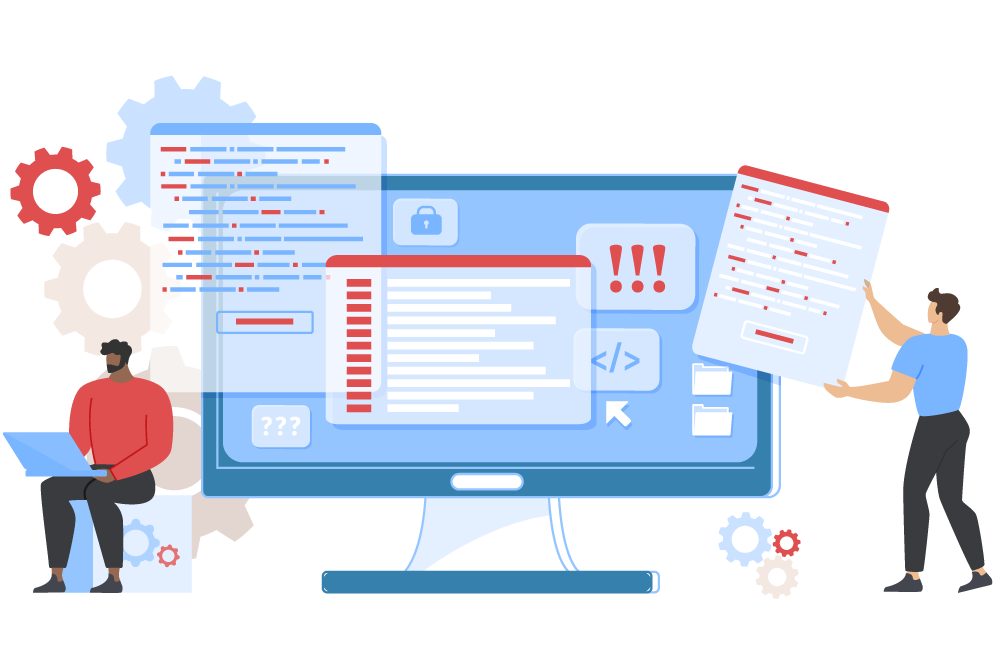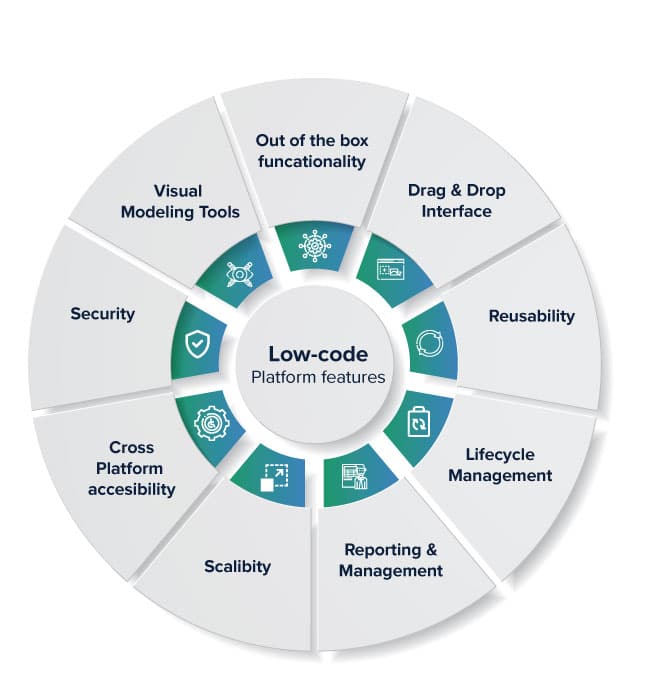Low-code development is a great method to create applications that are able to seamlessly integrate different systems and services. Here are some of the principal benefits: pre-built connectors and APIs.
A Wide Variety of Connectors. Low-code systems typically include an array of pre-built connections for business systems that are well-known (e.g. cloud services, databases, CRM). This allows for easier integration with systems.
API Integration: A lot of low-code platforms have integrated API capabilities out of the box that allow developers to connect easily with external services and sources of data.
User-friendly:
Drag-and-Drop Integration: Many integration tasks can be performed using drag-and drop interfaces. This lets developers and non-developers to design complicated integrations using little or no code.
Visual Workflow Creators: These visually appealing tools used to create workflows and data flow make it easier for users to comprehend the integration process.
Standardized Integration Methods:
SOAP/RESTful Service Support: Standard web service protocols, such as SOAP/REST, facilitate the integration of a variety of different systems and applications.
OData and Other Standards: Support for standards such as OData enables easy access and manipulation of data on different platforms and applications.
Real-Time Data Synchronization:
Real-Time Integrations: Lowcode platforms handle data synchronization at a real-time rate between systems and applications making sure that data is updated and uniform throughout an organisation.
Event-Driven Architecture: Certain platforms have event-driven architectural designs that allow applications to respond in real-time to events, which is essential for dynamic, interactive applications.
Legacy System Integration:
Low-code platforms provide many tools to integrate with older systems. They allow organizations to modernize IT without re-designing their current systems.
Data Migration: Built-in tools help transfer data from old applications to the latest ones developed on platforms with low-code.
Integration of Third Party Services:
Cloud Services Integration: The seamless integration of cloud services, such as AWS Azure, Google Cloud facilitates the easy deployment and scaling-up of applications.
Business Applications Low-code platforms can be used to connect with a variety of business apps like Salesforce, SAP or Microsoft Dynamics. They can create an integrated workflow for various business processes.
Simplified Data Processing
Data models that are unifying: A few platforms provide low-code support for unified data models to make data management easier across platforms.
Data connectors: Preconfigured data connectors allow easy access and modification to data from multiple sources.
Security and compliance:
Low-code platforms help ensure integrations are compliant with security standards and protocols to protect data during transit as well as in rest.
Features for Compliance - These platforms come with features that make sure that the integrations are in compliance with regulatory requirements.
Extensibility:
Custom Code and Scripts: Low-code platforms are often able to accommodate more complex integrations through the use of scripts and custom code. This allows for greater flexibility without compromising on user-friendliness.
Plug-in Ecosystems: A plug-in ecosystem can be used to extend the integration capabilities and allows users to add more features in the event of need.
Overall, the low-code platform's capabilities to integrate make it a powerful instrument to create interconnected applications that are scalable and efficient. They simplify the process of connecting disparate systems, increase the flow of information, and allow enterprises to use existing technologies while adopting new ones, which results in the integration of a seamless IT environment. Read the top Low-code Platform for application development info for more advice including build with docker, no code platforms, stored sql procedures, app modernisation, push notifications, develop cross platform mobile app, cross platform mobile dev, database in azure, application modernisation, develop web app and more.

Scalability And Flexibility Are Two Advantages Of Low-Code Application Development
Low-code application development offers a variety of advantages, including scaling and a flexible design for the application. These are essential in creating apps that adjust to the changing demands and evolve with the company. Here are some of the major advantages Rapid scaling:
Cloud-based deployment: A lot of lowcode platforms run on the cloud, which enables applications to grow with the infrastructure. This allows companies to handle an increase in demand without worrying about managing servers.
Auto-Scaling Feature: Built-in features that automatically scale resources in order to meet demand can ensure consistent performance without manual input during peak times.
Flexible Architecture:
Low-code platforms encourage modular design where components can independently developed, tested and scaled. This modularity is a great method to improve flexibility. It also makes it easy to update and expand parts of an application without having the whole application affected.
Microservices Integrate: They allow applications to expand and be flexible because they can be designed as a set of services that are loosely connected.
Custom-designed solutions:
Extensibility. Low-code platform typically allows for scripting or programming that is custom. This enables developers to expand the functionality of the application beyond the capabilities it offers out of the package. This allows the fulfilment of specific business requirements without limits.
Third-Party Integrations: The ability to integrate with third-party services and APIs enables businesses to incorporate additional functionalities and services when needed, enhancing the application's capabilities.
Agile Development and deployment:
Continuous Deployment and Deliver: Low code platforms support agile processes, allowing continuous deployment and integration (CI/CD). This allows applications to be upgraded and upgraded quickly as a result of user feedback.
Iterative development low-code development is an iterative process and therefore applications can be scaled and developed gradually. This decreases the risk of massive changes, while also allowing a controlled growth.
Resource Optimization
Efficient Resources Management: Low Code platforms can optimize the use of resources through tools that monitor and manage the performance of a program. This ensures that resources are utilized efficiently and can be scalable up or down based on actual demands.
Load Balancing : The integrated load balancing function distributes workloads evenly among servers. This enhances the application's capacity to handle the demands of high traffic and also ensures the same performance.
Global Reach
Multi-Region Implementation: Low-code platforms can be implemented across multiple geographical regions. This allows companies to provide users with low latency access worldwide. This is especially important for applications with users across the globe.
Localization Support Built-in support for localization allows the applications to be easily customized to suit different languages and requirements in different markets.
Maintenance and Updates:
Simplified Maintenance : Low-code applications with a modular and visual design makes maintenance easier. This lets the release of updates and bug fixes to be implemented quickly, without long periods of downtime.
Version Control: The integrated system for controlling version allows the safe deployment of rollbacks and updates. Versions from the past can be restored in the event that they're required.
Cost Efficiency:
Low-code platforms reduce development costs because they eliminate the need for complex programming. They allow developers to expand applications without need for a significant expenditure or effort.
Pay-As.-You-Go Lowcode platforms have flexible pricing models, such as pay-as.-you-go. These models align costs to actual usage and growth to provide financial flexibility.
Low-code development provides businesses with many advantages, such as scalability, flexibility and ad-hoc adaptability. This enables them to develop robust, flexible and scalable applications. These platforms allow rapid changes to meet changing demands, efficient resource utilization, and continuous enhancement. Applications can grow and evolve with the needs of the business. Have a look at the recommended Legacy application modernization with Low-code for blog info including build a docker container, cross platform mobile dev, ms azure sql, develop web application, azure sql databases, application development platforms, build a docker container, app development platform, paas service, paas service and more.

Benefits Of Low-Code Application Development In Terms Of Customization And The Limitations
Low-code development is an integrated approach that offers significant advantages in terms of solving limitations and allowing modification. Here are some of the main benefits:Handling limitations:
: .
Low-code development platforms are easy to use due to the fact that they come with already-built components, templates as well as other tools. They also allow for quicker deployment of even complex applications.
Guided Workflows: Several platforms provide guided workflows and wizards that help developers navigate through the maze of processes, decreasing the risk of mistakes and guaranteeing consistency.
Scalability Solutions
Scalability built-in: Lowcode platforms usually include features that enable an scalable architecture. They permit applications to cope with increasing demands without major changes.
Performance Monitoring: The integrated tools for monitoring performance and optimization ensure that applications are efficient as they expand.
Security and Compliance
Security features integrated into low-code platforms have security measures like encryption, role-based control of access and automated compliance checks, which address common security concerns.
Regular Updates: Platforms frequently upgrade their security protocols and security measures to ensure that applications remain secure against new threats.
Features for Customization:
Extensibility:
Custom Code Integration : A low-code platforms typically allow for the integration of custom codes (e.g. JavaScript, Python), which allows developers to extend the functionalities beyond what the standard offers.
Custom Plugins and Moduls Developers can create custom plug-ins or modules that have specific features that are tailored to the specific requirements of a company.
APIs and integration
API Support - The extensive API support facilitates seamless integration with other services and systems, and allows for extensive modification.
Third Party Services: Low-code platforms typically provide pre-built connectors for well-known third-party services, making it easier to integrate and customize applications.
Flexible UX/UI Designs:
Customizable interfaces: Users can customize and design their own user interfaces that will give an experience that is more customized.
Responsive Design: Built-in responsive design capabilities make sure that applications can be adapted to different sizes of screens and devices.
Business Logic Customization
Visual Workflow Builders: Visual tools that allow you to design and customize workflows, business logic and processes enable developers to design complicated and customized processes without lengthy programming.
Platforms can provide conditional logic to adapt to specific business rules or scenarios.
Data Management
Custom Data Models Developers have the ability to create custom data models that are tailored to specific business needs. This will ensure that the handling of data is customized for each application.
Advanced Data Processing: Integration with sophisticated tools and capabilities for data processing allows customizing how data is processed, analyzed and utilized in your application.
How to balance customisation with limitations:
Frameworks and Standards
Low-code platforms encourage the use of industry-standards and best practices. This results in top-quality software that is flexible and safe.
Governance Frameworks - Built-in governance structures make sure that any modifications do not interfere with security, integrity or adherence.
Iterative Development & Feedback
Rapid Prototyping: The capacity to quickly prototype and test changes allows developers to modify their designs based on feedback from users, refining the application to better satisfy the user's needs.
Low-code platforms enable constant improvement through the continuous improvement of their design and enhancements the platform as requirements of business evolve.
User Empowerment
Empowering Citizen Entwicklers In giving non-developers the capability to personalize their apps using simple interfaces as well as low-code platforms they increase the number contributors who can enhance and tailor application.
Training and Support A lot of platforms provide comprehensive training and support for users in the process of customizing their applications, while not compromising its stability or performance.
Overall, Low-code application creation offers a framework that is sturdy and adaptable enough to handle constraints while also allowing ample customisation. This balance enables businesses to build and maintain apps that function, are tailored to their particular requirements and adhere to high standards in terms of quality, security and scaleability.
